Did you know over 5,530,000 tonnes of bananas were consumed in the EU in 2022?
Yet only 583,000 of these were produced in the European Union. This means that nearly five million tonnes of bananas were imported to the European Union in 2022 from outside countries.
So, where do they come from?
Although bananas originated in Southeast Asia and The Philippines remains a key provider of bananas globally, the majority of banana production is now in Latin America. For the last five years, the EU has imported over four million tonnes of bananas from Latin American countries. This accounts for over 70% of the European Union’s banana consumption.
The other main source of imports is from African, Caribbean, and Pacific (ACP) members. The ACP is a collection of countries from their respective regions who have a blanket agreement with the European Union, formally known as the ACP-EC Partnership Agreement.
With Latin America and ACP countries being so far away from the European Union, it takes careful planning to deliver bananas in good condition to your shopping basket.
How are bananas transported?
Bananas are harvested whilst they are still green so that they maintain their shelf life over the ocean transit, which takes one to two weeks depending on destination and weather. The majority of banana imports for the EU arrive in Belgium and The Netherlands.
The bananas are packed in reefer containers, which are set to 13.3°C. This temperature will be maintained until the bananas are unpacked.
On arrival to the EU, the bananas are sent to warehouses and left in cold storage until they are required by shops. They are then unpacked and sent to ripening rooms, where they are fumigated with ethylene gas to trigger the enzyme reactions in the bananas that turn them yellow.
From here, the bananas may be packaged (if they aren’t pre-packed) and are sent to shops for you to purchase.
Where do customs fit into this?
Bananas are a food product and a plant, which normally means a phytosanitary certificate is required. However, bananas are one of the five fruits that do not require a health certificate to be imported to the EU. The other four are pineapple, coconut, durian and dates.
Customs do need to collect revenue during the import clearance, but the duty is not calculated on value like it is for most commodities. Instead, the tax is calculated based on the net weight of the cargo. To determine the weight of the cargo, shippers must obtain a weighing certificate from an authorised body.
If the bananas are pre-packaged and the weight has been calculated based on package count and an average weight, then EU customs will often weigh samples from an import shipment to ascertain that the weight of the packaging has been correctly calculated and that the net weight on the certificate is within 1% of the weight that they get from their testing.
Looking to import bananas?
Customs Support provide import and export clearance services across the EU and UK, including every major port in Belgium and The Netherlands. Contact one of our experts to discuss importing bananas into the EU today.














